What's Inside?
- What is Provident Fund (PF)?
- Benefits of Provident Fund (PF)
- Eligibility Criteria for Provident Fund (PF)
- Documents required for registering for Provident Fund (PF)
- When can an employee withdraw PF?
- When is PF partial withdrawal permitted?
- EPF withdrawal without employer signature
- Link Your Aadhaar with Your UAN and PF
- Employees’ Provident Fund (EPF) Tax rules
- EPF Interest Rate
- How to Check EPF Balance?
- Types of EPF Forms
- EPF Joint Declaration Form
- Documents you Have to Attach with PF joint declaration
- EPF Passbook
- EPFO account holders can update exit date online after a job change
- Importance of updating the exit date
- EPF Claim Status
- EPFO digital signature
- PF Toll Free Number
- Which is better?
- PF vs SIP
- PF vs FD
- PF vs LIC policy
- FAQs on EPF
- What is EPF?
- How does EPF work?
- Can I withdraw my EPF before retirement?
- How can I check my EPF balance?
- Can I transfer my EPF when changing jobs?
- What is the role of the employer in EPF?
- Can I nominate a beneficiary for my EPF account?
- How is the interest calculated on EPF?
- What is the UAN (Universal Account Number)?
What is Provident Fund (PF)?
The Employees’ Provident Fund (EPF) serves as a retirement savings scheme tailored for individuals employed in the private or unorganized sectors. Administered by the Employees’ Provident Fund Organisation (EPFO), EPF, commonly referred to as Provident Fund (PF), stands as a compulsory investment initiative for employees. It works as a savings scheme, where a portion of the employee’s salary is deducted and an equal amount is contributed by the employer. These contributions form a retirement fund for the employee.
After retiring, employees are entitled to a single payment encompassing their own and the employer’s contributions, along with accrued interest. Both the employee and employer must contribute a minimum of 12% of the monthly salary plus dearness allowance. However, for entities with fewer than 20 employees, the contribution stands at 10% of the salary plus dearness allowance. EPF enrollment is mandatory for all employees, irrespective of their sector of employment, be it governmental or non-governmental.
Under the regulations, businesses employing over 20 individuals are required to enroll with the Employees’ Provident Fund Organisation (EPFO). Workers who consistently contribute to the fund for a duration of 20 years or beyond are entitled to an extra bonus of Rs. 50,000 upon their retirement.
Benefits of Provident Fund (PF)
In India, the Provident Fund (PF) stands as a compulsory retirement benefit governed by the Employees Provident Fund and Miscellaneous Provision Act of 1952. It offers various benefits to employees, which include:

- Tax Benefit: The amount contributed by the employee to the EPF is exempt from income tax under Section 80C. Moreover, the income generated from the Provident Fund (PF) is also free from taxation.
- Insurance: The EPFO provides insurance coverage to subscribers through the Employees’ Deposit Linked Insurance scheme. If the employee passes away, the nominated individual is entitled to receive up to a maximum of Rs. 6 Lakhs as benefits.
- Premature Withdrawal: The EPF account offers the flexibility for subscribers to withdraw funds prematurely in situations of unexpected emergencies. This provides flexibility and helps individuals meet urgent financial needs.
- Greater Returns: A portion of the PF funds is invested in Stock Markets through Exchange Traded Funds (ETFs). This creates the opportunity to achieve greater returns on the initial investment.
- Pension: A portion (8.33%) of the employer’s contribution goes towards the employee’s pension scheme. The remaining amount is added to the employee’s provident fund. As a result, a pension fund is established, guaranteeing a secure and comfortable lifestyle post-retirement.
Eligibility Criteria for Provident Fund (PF)
The requirements to qualify for the Provident Fund (PF) scheme in India include:
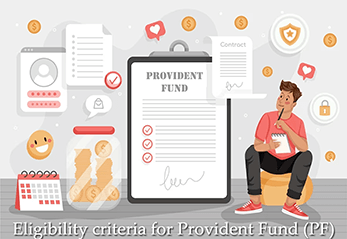
- Any company with a workforce of 20 or more must enroll in the PF scheme, ensuring they extend PF benefits to their employees as per mandatory regulations.
- Workers with a monthly basic salary not exceeding Rs. 15,000 qualify for Provident Fund (PF) coverage. The basic salary includes basic wages, dearness allowance, and retaining allowance, if any. It does not include other allowances such as house rent allowance, overtime allowance, bonus, etc.
- It’s worth emphasizing that even organizations with fewer than 20 employees have the option to voluntarily enroll in the PF scheme, thereby offering its benefits to their workforce.
- Workers with a monthly salary surpassing Rs. 15,000 can choose to enroll as voluntary members of the Provident Fund (PF), provided both their employer and the PF authorities agree to it.
- Once an employee becomes eligible for PF, they are required to contribute a certain percentage of their basic salary towards the PF account, and the employer also contributes an equal amount. The present rate of contribution stands at 12% of the employee’s basic salary combined with the dearness allowance.
Documents required for registering for Provident Fund (PF)
To enroll in the Provident Fund (PF) scheme in India, you’ll typically need the following documents:

- Employer’s Documents:
- Certificate of Incorporation (for companies)
- Partnership Deed (for partnership firms)
- Registration Certificate (for societies, trusts, and other entities)
- Memorandum and Articles of Association (for companies)
- PAN Card of the organization
- Address proof of the organization (such as electricity bill, rent agreement, etc.)
- A cancelled check or a bank statement from the organization’s bank account.
- Employee’s Documents:
- Aadhaar Card
- PAN Card
- Information pertaining to one’s bank account, such as a cancelled cheque or a bank statement.
- Address Proof (such as Aadhaar Card, Passport, Voter ID, etc.)
- Evidence of one’s date of birth, which may include documents like a Birth Certificate or a School Leaving Certificate, serves as verification for one’s birthdate.
- Details of the nominee, including their name, address, and their relationship with the employee.
It’s crucial to acknowledge that the necessary criteria and paperwork can differ based on the location and the guidelines set by the Employees’ Provident Fund Organization (EPFO).
When can an employee withdraw PF?
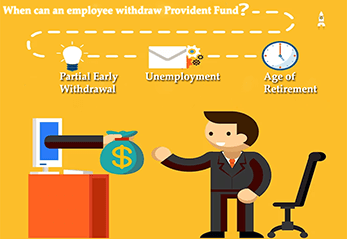
The Employees’ Provident Fund (EPF) is a financial reserve established by contributions from employees, employers, and the government, designed to provide financial security for individuals in their retirement years. Upon retirement, employees are entitled to withdraw the accumulated sum from their EPF account, along with accrued interest. However, specific conditions must be fulfilled to access funds from the Employees’ Provident Fund Account (EPFA).
- Age of Retirement: Once an employee reaches the retirement age, they are eligible to withdraw the total sum they have accumulated, along with any accrued interest.
- Unemployment: In case of unemployment lasting for a month, one can withdraw 75% of the saved amount. However, if the unemployment persists for two months or beyond, the remaining 25% can be withdrawn.
- Partial Early Withdrawal: In specific cases like marriage, higher education, making a down payment for a house, or medical emergencies, individuals can make a partial early withdrawal from the fund before their retirement. However, certain conditions must be fulfilled to be eligible for this option.
When is PF partial withdrawal permitted?
Partial withdrawal from the Provident Fund (PF) account is permitted in specific circumstances before an employee’s retirement. Partial withdrawal, alternatively referred to as an advance or loan, is accessible for specific intentions:

- Marriage: An employee is eligible to withdraw a portion of their Provident Fund (PF) for specific personal events such as their own marriage, their children’s weddings, or the weddings of dependent siblings. Typically, there is a minimum tenure of service that must be met to qualify for withdrawal.
- Education: Employees have the option to make partial withdrawals for the purpose of financing higher education for themselves, their children, or dependent siblings. However, eligibility for this benefit may be subject to specific conditions tied to the employee’s tenure of service.
- Home Loan Repayment: Employees can make a partial withdrawal to make a down payment or meet other housing-related expenses for purchasing or constructing a house or flat.
- Medical Emergencies: In instances of significant medical conditions or necessary medical procedures, individuals are allowed to make partial withdrawals from their Provident Fund (PF) accounts.
EPF withdrawal without employer signature
EPFO (Employee Provident Fund Organization) has made it easier for employees to withdraw their PF (Provident Fund) without needing their employer’s approval or signature. The EPF system underwent a transformation with the implementation of the Universal Account Number (UAN), leading to this alteration. Now, employees can make withdrawals by linking their Aadhaar card to their UAN. There are two ways to withdraw funds without the employer’s signature: with or without an Aadhaar card.
With an Aadhaar card:
Now, by simply linking your Aadhaar card to your UAN (Universal Account Number), you don’t need your employer’s signature anymore for certain processes. To simplify matters, ensure that both your Aadhaar card and bank information are kept up-to-date within the EPFO’s member portal.
Before commencing the withdrawal process, it’s imperative that your employer has already authenticated your Aadhaar card and bank information. Additionally, ensure that your Universal Account Number (UAN) is activated beforehand.
After fulfilling the specified criteria, proceed to acquire Form 19-UAN for withdrawing funds from your Provident Fund (PF) and Form 10C-UAN for pension scheme withdrawals. Fill in your name, address, registered mobile number, PAN card number, the reason for leaving your job, and your joining date. Make sure the details match those on your Aadhaar card and bank account. Any discrepancies could result in your application being rejected or delayed.
Please ensure to include a canceled cheque with the form before submitting it to the EPF office in your region.
Making a withdrawal without an Aadhaar Card:
Although it may be a bit inconvenient, if you have no other choice, follow the steps below:
- Download the required form (Form 19, Form 31, or Form 10C) from the EPFO’s member portal. Choose the form based on where you want to withdraw your funds from.
- Fill out the form completely. Make sure to get it attested by an authorized signatory, such as a Gazetted officer, bank manager, or magistrate. The authorized signatory should sign each page of the form.
- If you can’t obtain your employer’s signature, you must offer an explanation. Specify “Non-cooperation” as the rationale.
- The employer must attach an indemnity bond along with a 100 Rupee stamp paper. Please provide your payslips, employment ID, appointment letter, and Form 19. Avoid any repetition of documents already mentioned.
- Please assemble your standard KYC documents, such as proof of address and identity. Additionally, include the attested form, a cancelled cheque, and any other necessary verification documents.
- Please make a trip to the local EPF office and ensure you provide all the required documents listed earlier.
Link Your Aadhaar with Your UAN and PF
Umang App

Step 1: Download the Umang App on your phone.
Step 2: Open the app and select ‘eKYC services’.
Step 3: Search for the ‘Aadhaar Seeding Option’ and then select or touch it.
Step 4: Please input your UAN (Unique Account Number).
Step 5: You will be sent a unique password for one-time use, known as a One-Time Password (OTP).
Step 6: Enter your Aadhaar number.
Step 7: A new One-Time Password (OTP) will be sent to your mobile device.
Step 8: After inputting the OTP, your Aadhaar will be successfully associated with your UAN.
OTP Verification on EPFO e-KYC Portal
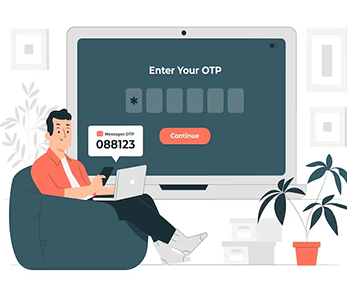
Step 1: Visit the EPFO website and access your account by logging in.
Step 2: Find the selection labeled ‘For employees’ and give it a click.
Step 3: Choose ‘Link UAN Aadhaar’ from the available options.
Step 4: Enter your UAN and mobile number in the provided fields.
Step 5: You will receive a one-time password (OTP) on your mobile number.
Step 6: Enter your Aadhaar card details as requested.
Step 7: Select the method for verifying your Aadhaar card.
Step 8: A new one-time password (OTP) will be sent to your mobile number to verify your identity.
Step 9: After the verification process concludes, your Aadhaar card will be successfully connected to your UAN.
On EPFO portal
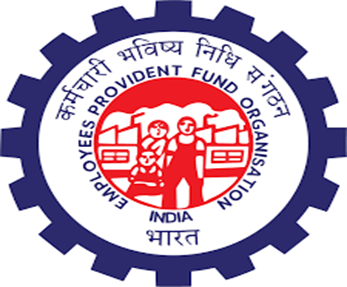
Step 1: Go to this website: https://unifiedportal-mem.epfindia.gov.in/ and log in to the EPFO Unified Portal.
Step 2: Click on the “Manage” tab.
Step 3: Choose the option called ‘KYC’.
Step 4: Select your Aadhaar card as your KYC document.
Step 5: Enter your Aadhaar number and your name as it appears on your Aadhaar card.
Step 6: Click on the “Save” button.
Step 7: Your KYC status is currently marked as ‘Pending’ and will be reviewed for approval at a later time.
EPFO (Employees’ Provident Fund Organisation) is a statutory body established by the Government of India under the Employees’ Provident Funds and Miscellaneous Provisions Act, 1952. The Employee Provident Fund Organization (EPFO) operates under the jurisdiction of the Ministry of Labour and Employment, overseeing its administrative functions. The primary purpose of the Employees’ Provident Fund Organisation is to manage and administer the Employees’ Provident Fund (EPF) and other social security schemes for the organized sector employees in India.
Employees’ Provident Fund (EPF) Tax rules
Here are some points about the tax rules for the Employees’ Provident Fund (EPF):
- Withdrawals from the Employee Provident Fund (EPF) may incur taxes if the employee has not maintained a continuous work period of at least five years.
- If the employee changes jobs and transfers the EPF to the new employer, the new employment period is also considered for the 5-year calculation.
- If the continuous service period is less than 5 years, the employer’s contribution and the interest earned on it will be taxable under the “Income from Salaries” category.
- The portion of the EPF that an employee contributes themselves qualifies for tax exemption according to Section 80C of the Income-tax Act.

Taxation on EPF Withdrawal:
- If you withdraw before serving for a full five years, taxes are automatically deducted at the source, known as TDS.
- If PAN (Permanent Account Number) is provided, 10% TDS is deducted, and if PAN is not furnished, 34.608% TDS is deducted.
- However, no TDS is deducted if the withdrawal amount is less than Rs. 50,000.
Exceptions to TDS:
- The TDS regulation doesn’t come into effect when the cessation of employment is due to circumstances beyond the individual’s influence, such as company lockouts, retrenchments, or employee layoffs.
- TDS is also not applicable when the service cannot be continued due to serious medical conditions like physical or mental disability.
EPF Interest Rate
The PF interest rate is currently 8.15%. You can easily calculate the amount of interest that accumulates in your EPF account by the end of the financial year. The accumulated interest is combined with the contributions from both the employer and the employee to calculate the overall balance in the account.
How to Check EPF Balance?
There are four simple ways available to effortlessly check your EPF balance.
- EPFO portal: Go to the EPFO member portal and log in using your UAN (Universal Account Number) and password. After successfully logging in, your EPF balance can be easily accessed using your unique member ID.
- UMANG app: Download the UMANG app on your mobile phone. This application offers the convenience of checking your EPF balance, along with the functionality to initiate and monitor claims pertaining to your EPF.
- Missed call service: Give a missed call to the number 011-22901406 from your registered phone number. You can expect to receive a text message containing information about your EPF balance.
- SMS service: If your UAN is activated, you can send an SMS to 7738299899 to check your EPF balance. You can expect to receive a text message containing the balance of your Employee Provident Fund (EPF).
Types of EPF Forms
EPF Form |
Form Name |
Use/Purpose |
|---|---|---|
Form 19 |
EPF Withdrawal |
Used for making a final settlement claim by employees who have left their job and want to withdraw their accumulated EPF balance. |
Form 10C |
Pension Withdrawal |
Used by employees to withdraw the accumulated pension amount if they have completed less than 10 years of service. |
Form 31 |
Advance/Loan |
Used to request a partial withdrawal or loan from the EPF account for specific purposes like buying a house, medical emergencies, education, etc. |
Form 13 |
Transfer of EPF |
Used by employees who want to transfer their EPF balance from one employer’s account to another employer’s EPF account. |
Form 14 |
Investment Declaration |
Employees use this form to declare their investments and tax-saving details at the beginning of the financial year for the purpose of EPF deductions. |
Form 11 |
Declaration Form |
This form is filled by new employees when joining an organization to declare their previous employment details, UAN (if applicable), and other necessary information. |
Form 5 |
Return of Employees |
Employers use this form to provide details of new employees, as well as employees who have left the organization during a specific period. |
Form 2 |
Nomination |
Used by employees to nominate a person who will receive the EPF accumulations in case of the employee’s demise. |
Form 6A |
Annual Return |
Employers submit this form to the EPFO to provide details of the EPF contributions made by the employees and the employer during the financial year. |
Form 9 |
Reconciliation of EPF/EDLI Contributions |
Employers use this form to reconcile any discrepancies in the EPF and EDLI (Employees’ Deposit-Linked Insurance) contributions made during a specific period. |
Kindly be aware that various EPF forms serve different purposes, and while these are among the frequently utilized ones, there exist several others tailored for various needs.
EPF Joint Declaration Form
The EPF joint declaration form is a secure form that you, as an employee, and your employer sign. This document is utilized to rectify details within your PF (Provident Fund) account. It allows for adjustments regarding information such as your date of birth, date of joining, name associated with UAN (Universal Account Number), your father’s name, and date of exit.
The EPF joint declaration form includes the following details:
- Father’s Name or Husband’s Name
- Name of the Employee
- Employee’s Date of Birth
- Provident Fund Account Number
- Date of Leaving the Company
- Date of Joining the Company
- Employee’s Gender
You have the option to both view and download the EPF joint declaration form in a specific format provided.
- Joint Declaration by the Member or Employer
- Date of Submission
- The location of your nearby Provident Fund (PF) commissioner’s office is as follows: [Insert specific address here].
- The subject should be the same as your Joint Declaration by Member and the Employer
- Enter your name and the company name
- Write your Establishment Code and the name of the company
- Your UAN number
- PF Number
Documents you Have to Attach with PF joint declaration
To provide proof for any changes related to your personal information, you need to submit specific documents along with the EPF joint declaration form. Here are the requirements for different situations:
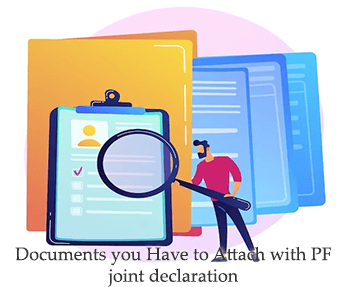
- Change in Date of Birth: To update your date of birth, you must submit one of the following documents: school certificate, mark sheet, birth certificate, or passport.
- Name Change: If you have changed your name, you need to attach documents that have your new name on them.
- Date of Joining or Date of Leaving: For updating your date of joining or date of leaving, you should submit your joining letter or leaving letter as proof.
Ensure that you include all required verified documents, alongside the EPF joint declaration form, and don’t forget to sign the form before submitting.
EPFO Employee Login
To login to the EPFO portal, employees can follow these simple steps. First, go to the website https://www.epfindia.gov.in/site_en/index.php. Then, use your UAN (Unique Account Number) and password to login. Once logged in, you can perform various tasks like claiming PF, updating KYC details, checking PF balance, and transferring PF amount.
EPFO Employer Login
Upon initial access to the EPFO employer portal, employers are required to establish a unique username and password. This can be accomplished by visiting the designated URL: https://www.epfindia.gov.in/site_en/For_Employers.php. Once logged in, employers gain the ability to verify and authorize their employees’ KYC information, alongside carrying out various associated duties.
EPF Passbook
You can use the EPFO passbook service to check and download statements of your EPF account. This service is accessible to every member who has completed the registration of their Universal Account Number (UAN) on the EPFO portal.
The EPFO passbook contains important information like your name, establishment ID, EPF scheme details, and the name of the EPF office.
EPFO account holders can update exit date online after a job change
The EPFO (Employee Provident Fund Organization) has added a new feature to their official website. Now, employees can update their “date of exit” online when they change jobs. Before, sole authority to update exit dates online rested with employers.
Here are the steps to update your date of exit online:
- Go to the EPFO’s official website.
- Access your account by entering your Universal Account Number (UAN) along with your password.
- Find the “Manage” section and click on it.
- Select “Mark Exit” from the options.
- A dropdown menu called “Select Employment” will appear. Choose your PF account number from the list.
- Please provide the date you departed and state the reason for your departure.
- Click on “Request OTP.” An OTP (One-Time Password) will be sent to the mobile number linked to your Aadhaar card.
- Enter the OTP you received.
- Check the provided checkbox.
- Click on “Update” and then “Ok.”
- You’ll get a notification verifying the successful update of your exit date.
- To check out your latest details, head over to the “View” section and opt for “Service History.”
- In that place, you’ll discover the entry and departure dates for both your EPS and EPF accounts.
Importance of updating the exit date
It’s crucial to ensure that your departure date is kept up-to-date for any claims or settlements. If your exit date is not updated or is incorrect, your employment will not be considered continuous. This means you may have to pay taxes on the interest earned during that time.
EPF Claim Status
When a member wants to withdraw their EPF funds, they can go to the EPFO portal and submit a request online. They can also check the status of their EPFO claim through the same portal.
Employees have multiple options to inquire about the status of their claim. They can either give a missed call to 011-22901406 from their registered mobile numbers, utilize the SMS service, or access the UMANG app.
To check the PF status, the member needs to provide the following information:
- Employment details
- Extension code (if applicable)
- Employer’s EPF regional office
- Universal Account Number (UAN)
EPFO digital signature
To streamline and enhance the process of transferring EPF claims, the EPFO (Employee Provident Fund Organization) has implemented a digital signature mechanism for employers. This allows employers to authenticate claims by utilizing their digital signatures, ensuring greater ease and transparency in the process.
When an individual changes employers, they must have their transfer claim verified by either their previous or current employer. This verification process involves the utilization of the employer’s digital signature. In the past, employers had to fill out Form 13, get it signed by their employers, and then submit it to the regional EPF office.
Now, the process has been simplified. Employers can complete this task on the EPFO’s member portal. To obtain a digital signature, employers need to apply for a digital certificate. This certificate holds individual information including their name, email address, APNIC account identifier, public key, and the nation where they work. The digital certificate is issued by a Certifying Authority and contains the necessary identification key with the required details, which will be embedded in the EPFO’s member portal.
PF Toll Free Number
If you require help or have queries regarding your UAN (Universal Account Number) or Know Your Customer (KYC) information, feel free to reach out to EPFO (Employees’ Provident Fund Organization) through their Toll-Free Number: 1800 118 005.
To access funds from an unclaimed EPF (Employee Provident Fund) account, adhere to these straightforward instructions:
- Visit the EPFO website and complete the required form for claiming EPF benefits.
- Submit the completed form at the post office.
- You will receive the PF amount within 3-20 days after the submission of the form.
Which is better?
PF vs SIP
A Systematic Investment Plan (SIP) allows individuals to invest in mutual funds at regular intervals, whereas the Employees’ Provident Fund (EPF) is a savings scheme tailored for employees in the private sector. Below is a comparative table highlighting the distinctions between the two investment options:
Criteria |
Provident Fund (PF) |
Systematic Investment Plan (SIP) |
|---|---|---|
Purpose |
Retirement savings and long-term financial security |
Wealth creation and investment growth |
Nature of Investment |
Fixed income with assured returns |
Market-linked investment with potential for higher returns |
Contribution |
Employer and employee contribute to the PF account |
Investor makes regular contributions into mutual funds |
Tax Benefits |
Tax-exempt on contributions, interest, and withdrawal |
Tax benefits on investment (ELSS) and long-term capital gains |
Liquidity |
Limited withdrawal options until retirement |
Generally, more flexible withdrawal options |
Risk |
Low risk as it is backed by the government |
Market risk associated with investment performance |
Investment Control |
Limited control over how funds are invested |
Investors have control over fund selection and allocation |
Returns |
Generally lower, but assured |
Varies based on market performance and fund selection |
Lock-in Period |
Generally until retirement or specific conditions |
No lock-in period, but recommended for long-term investing |
Accessibility |
Accessible through the employer |
Accessible through mutual fund companies and intermediaries |
PF vs FD
The table below highlights the distinctions between Provident Fund (PF) and Fixed Deposit (FD):
Criteria |
Provident Fund (PF) |
Fixed Deposit (FD) |
|---|---|---|
Nature |
Mandatory contribution towards retirement savings. |
Voluntary investment option. |
Purpose |
Long-term retirement savings. |
Short to medium-term investment. |
Returns |
Generally offers higher returns over the long term. |
Offers fixed interest rates. |
Interest Rate |
Determined by the EPFO, subject to change. |
Fixed interest rate offered by the bank. |
Risk |
Relatively low risk as it is backed by the government. |
The level of risk varies depending on the specific financial institution, but generally speaking, it tends to be relatively low. |
Liquidity |
Partial withdrawal possible under certain conditions. |
Generally less liquid, with penalties for early withdrawals. |
Tax Benefits |
Contributions eligible for tax deduction under Section 80C. Interest and maturity amount are tax-free. |
Income generated from interest is subject to taxation based on the individual’s income tax bracket. Tax Deducted at Source (TDS) might be enforced on such earnings. |
Lock-in Period |
Typically, until retirement or withdrawal under specific circumstances. |
The duration of the Fixed Deposit (FD) depends on the specific tenure selected. |
Accessibility |
Accessible through employer and EPFO. |
Accessible to individuals through any bank or financial institution of their choice. |
Inflation Adjustments |
Offers some protection against inflation due to higher returns. |
It’s possible that it doesn’t offer sufficient defense against rising prices. |
Suitability |
Suitable for long-term retirement savings. |
Suitable for short to medium-term investment goals. |
PF vs LIC policy
Here’s a comparison between PF (Provident Fund) and LIC (Life Insurance Corporation) policy:
Criteria |
PF (Provident Fund) |
LIC (Life Insurance Corporation) Policy |
|---|---|---|
Purpose |
Retirement savings and financial security |
Life insurance coverage and investment options |
Contributions |
Contributions made by both employee and employer |
Premium payments made by the policyholder |
Returns |
Fixed interest rate determined by the EPFO |
Varies based on the policy and investment performance |
Maturity |
Can be withdrawn after retirement |
Policy term specified in the policy document |
Tax Benefits |
Eligible for tax deductions under Section 80C |
Tax benefits on premium payments and maturity proceeds |
Risk Coverage |
No specific risk coverage provided |
Provides life insurance coverage and additional riders |
Flexibility |
Withdrawals may have restrictions and penalties |
Limited flexibility based on the policy terms and options |
Portability |
Can be transferred to a new employer’s PF account |
Policies cannot be transferred, but can be surrendered |
Employer Contribution |
Employer contributes a portion to the PF account |
No employer contribution unless offered as an employee benefit |

